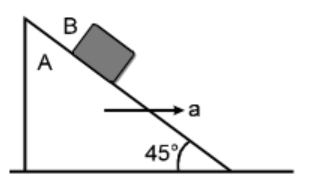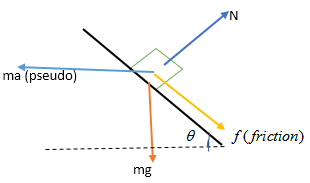
If the coefficient of friction between A and B is $\mu $. The maximum horizontal acceleration of the wedge A for which B will remain at rest w.r.t the wedge is

A. $\mu g$
B. $g(\dfrac{{1 + \mu }}{{1 - \mu }})$
C. $\dfrac{g}{\mu }$
D. $g(\dfrac{{1 - \mu }}{{1 + \mu }})$

Answer
563.1k+ views
Hint: Try to solve by taking A as a frame of reference and use pseudo force concept it will be easy that way you can also solve by taking ground as a frame of reference but then you will have to apply constraint equations which will make it little complex.
Complete step by step answer:
We will solve this question by taking wedge A as a frame of reference.
So free body diagram according as we observe B from A will be

balancing force perpendicular to incline we have,
$N = mg\cos \theta + ma\sin \theta $so
Friction $f = \mu N = \mu (mg\cos \theta + ma\sin \theta )$
And balancing force along the incline we have,
$f + mg\sin \theta = ma\cos \theta $
$ \Rightarrow \mu (mg\cos \theta + ma\sin \theta ) + mg\sin \theta = ma\cos \theta $
$ \Rightarrow a = \dfrac{{g\sin \theta + \mu g\cos \theta }}{{a\cos \theta - \mu a\sin \theta }}$ putting $\theta = {45^ \circ }$we have
$\therefore a = g(\dfrac{{1 + \mu }}{{1 - \mu }})$
So, the correct answer is “Option B”.
Note:
In these types of questions, choosing a frame of reference is critical because choosing a better frame of reference makes a lot of things easy here. For example, once we take wedge A as a frame of reference we won’t have to worry about constraint equations and it makes it easier to solve such questions.
Complete step by step answer:
We will solve this question by taking wedge A as a frame of reference.
So free body diagram according as we observe B from A will be

balancing force perpendicular to incline we have,
$N = mg\cos \theta + ma\sin \theta $so
Friction $f = \mu N = \mu (mg\cos \theta + ma\sin \theta )$
And balancing force along the incline we have,
$f + mg\sin \theta = ma\cos \theta $
$ \Rightarrow \mu (mg\cos \theta + ma\sin \theta ) + mg\sin \theta = ma\cos \theta $
$ \Rightarrow a = \dfrac{{g\sin \theta + \mu g\cos \theta }}{{a\cos \theta - \mu a\sin \theta }}$ putting $\theta = {45^ \circ }$we have
$\therefore a = g(\dfrac{{1 + \mu }}{{1 - \mu }})$
So, the correct answer is “Option B”.
Note:
In these types of questions, choosing a frame of reference is critical because choosing a better frame of reference makes a lot of things easy here. For example, once we take wedge A as a frame of reference we won’t have to worry about constraint equations and it makes it easier to solve such questions.
Recently Updated Pages
Master Class 12 Business Studies: Engaging Questions & Answers for Success

Master Class 12 Economics: Engaging Questions & Answers for Success

Master Class 12 English: Engaging Questions & Answers for Success

Master Class 12 Maths: Engaging Questions & Answers for Success

Master Class 12 Social Science: Engaging Questions & Answers for Success

Master Class 12 Chemistry: Engaging Questions & Answers for Success

Trending doubts
What is meant by exothermic and endothermic reactions class 11 chemistry CBSE

Which animal has three hearts class 11 biology CBSE

10 examples of friction in our daily life

One Metric ton is equal to kg A 10000 B 1000 C 100 class 11 physics CBSE

1 Quintal is equal to a 110 kg b 10 kg c 100kg d 1000 class 11 physics CBSE

Difference Between Prokaryotic Cells and Eukaryotic Cells




